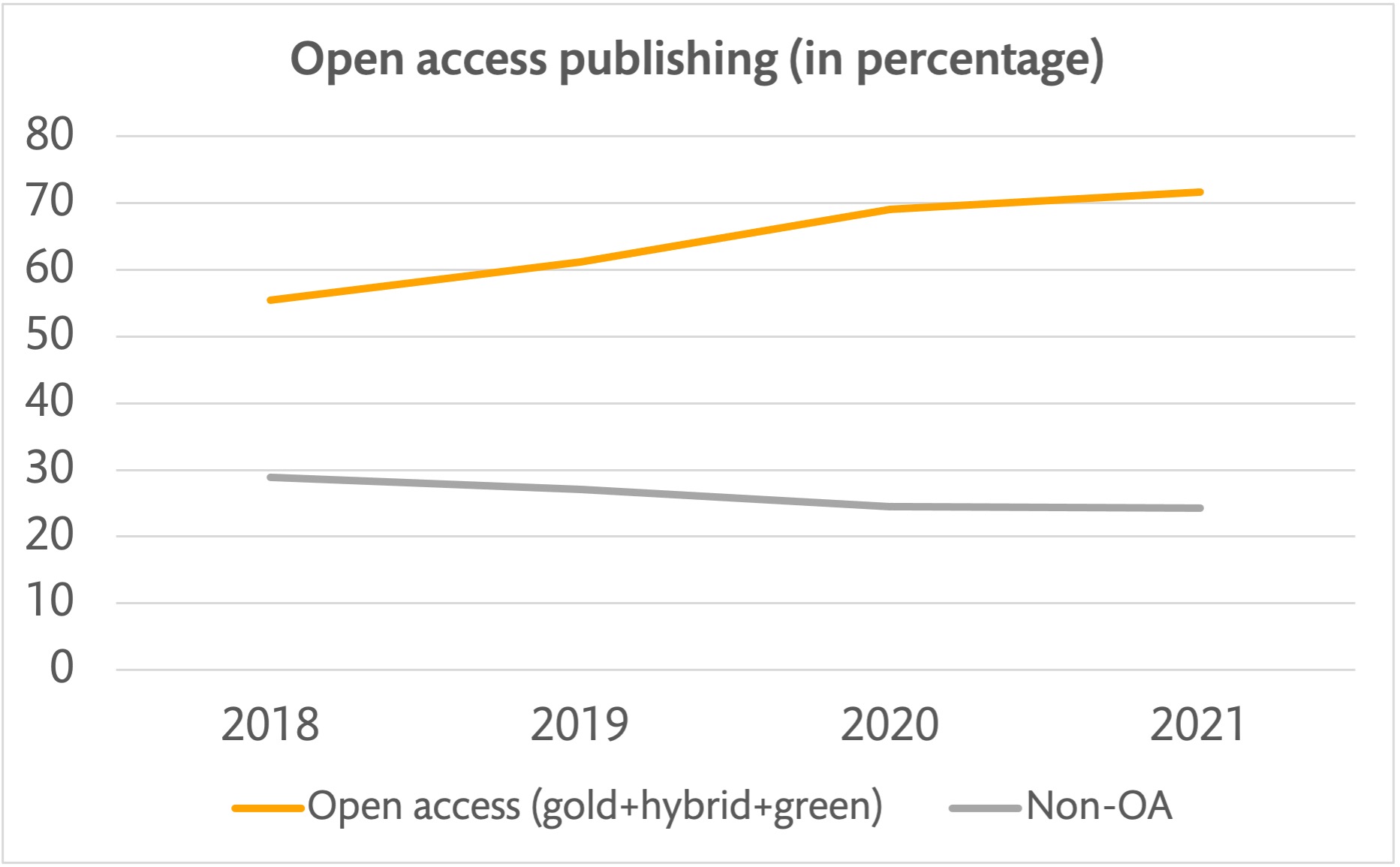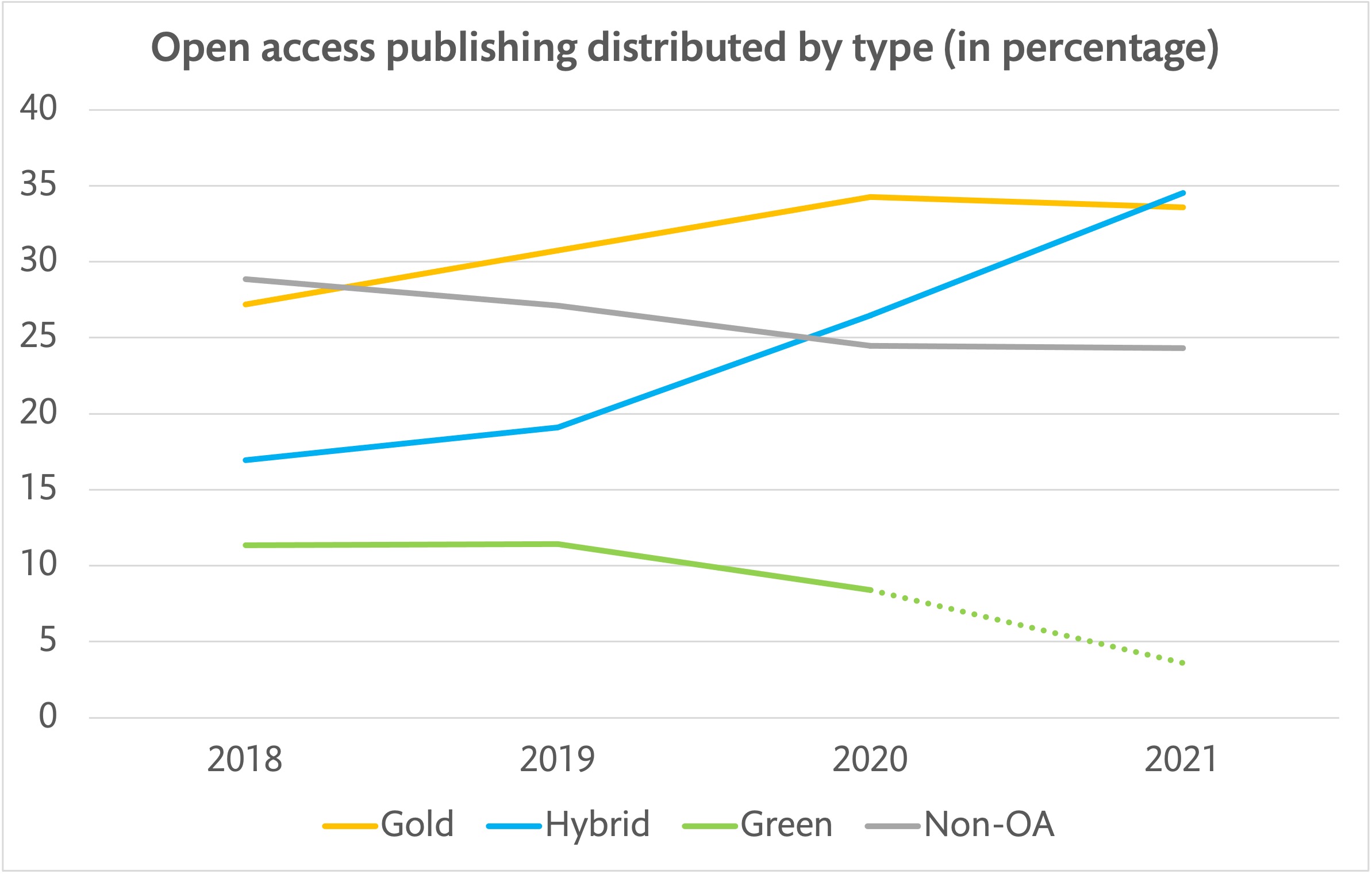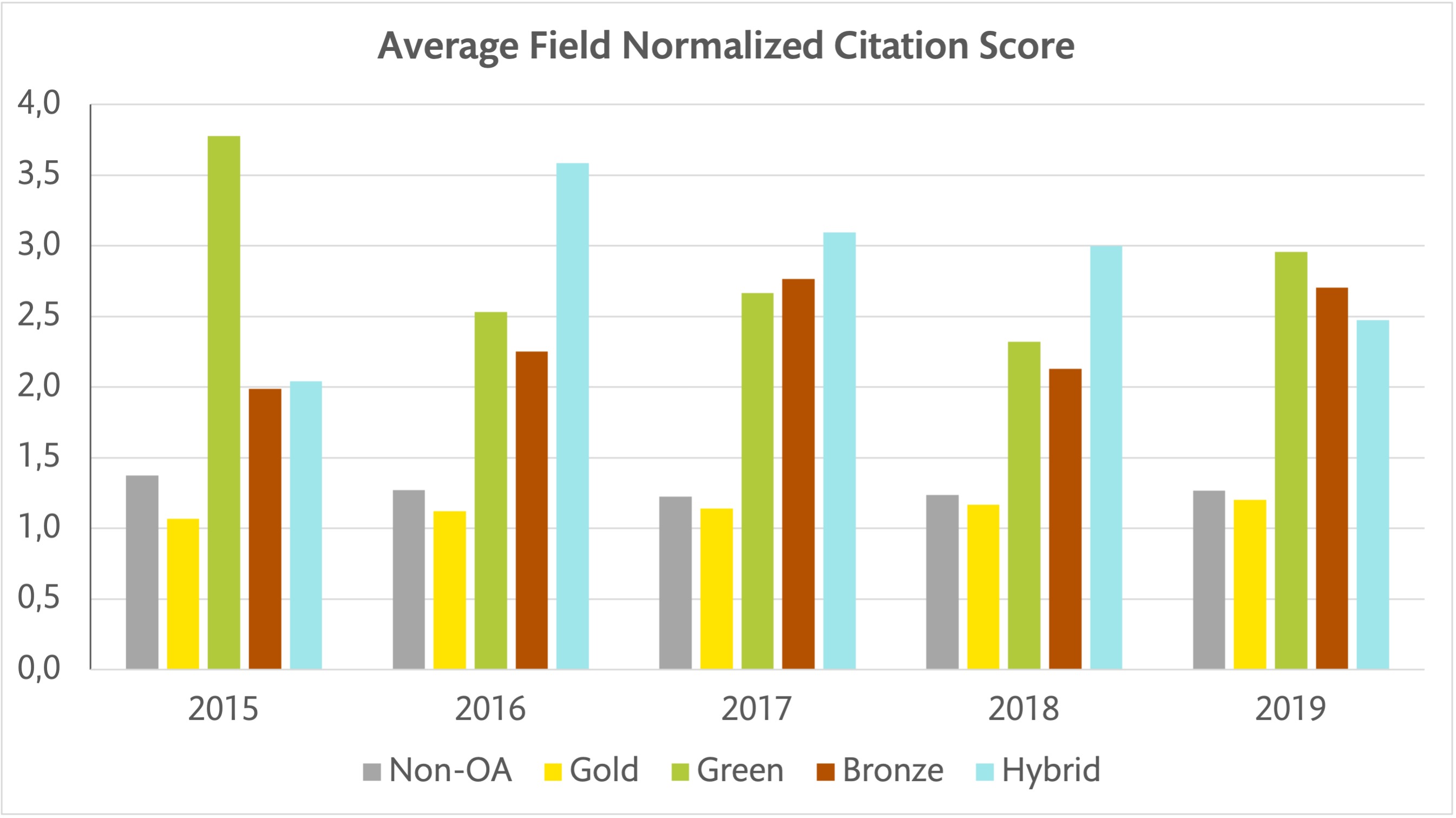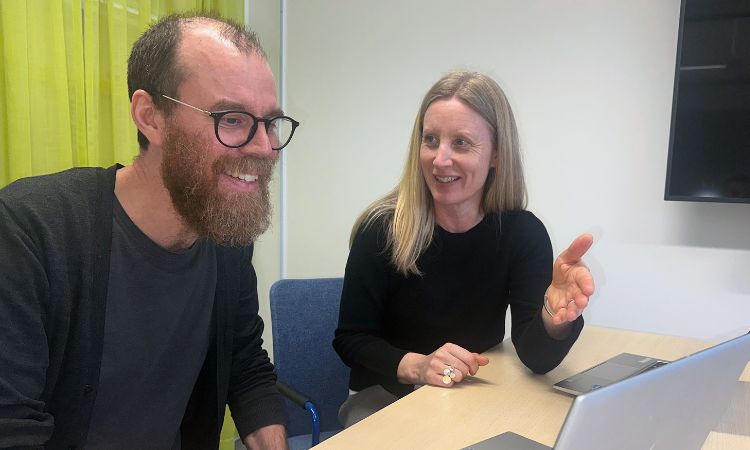Open access publishing on the rise at KI
Karolinska Institutet's policy for open publication, which in short states that KI's researchers must make their peer-reviewed publications open and freely available (open access, OA) under an open license, has existed in its current form for almost a year. In connection with the international open access week that is currently taking place, we will here present statistics on what the transition to open publishing looks like at Karolinska Institutet and to what extent open access publications are cited.
Open access publishing at KI is increasing

Preliminary figures for 2021 show that open access publishing at the university continues to increase, and 68 percent of KI's articles and review articles have so far been published directly open access, which means that the articles have been published either in pure OA journals (so-called gold open access) or as OA-articles in hybrid journals (hybrid open access). Green open access (self-archiving in open archives) can usually only take place after an embargo period of six to twelve months, so the proportion of green open access for the current year is likely to increase over time to levels similar to those at the beginning of the period.

KI's agreements for open access publishing
The publishing agreements that KI has concluded with publishers provide good conditions for publishing open access. The agreements mean that the publication fee / article processing charge (APC) is prepaid by Karolinska Institutet. In order for the agreements to be utilized, the corresponding author of the article must be KI-affiliated. At present, the agreements cover 17 publishers, which together hold 11,037 journals.
Reviewing the actual publications, the agreements seem to contribute to an increased share of open access at KI. Based on statistics on articles published by KI researchers during the years 2018-2021, the proportion of direct open access is higher if the article's corresponding author is from KI, compared with when the article's corresponding author does not belong to KI. Preliminary figures for 2021 show that 79 percent of articles with a KI-affiliated corresponding author have been published directly open access, compared with 59 percent for KI articles where the corresponding author is affiliated to another organization.
To simplify the process of publishing open access, the university library has developed a search tool, Open Access/APC Checker Tool, which makes it easier for KI researchers to see if a specific journal is included in KI's publishing agreements. Via this tool below, you can also find further author instructions for the journals included in the agreements.
In the Open Access/APC Checker Tool, you can search for a specific journal title to see if it is included in an open access agreement with prepaid APCs.
Open access publishing and citation impact
Articles published open access are easier to distribute and can more easily reach more readers than articles published in subscription-based journals. There are several studies that show that open access publishing also leads to more citations (Langham-Putrow A, Bakker C, Riegelman A, 2021). We have studied whether it is possible to confirm this by looking at citations for KI articles.

A citation analysis of KI's publication 2015–2019 shows that articles available open access have a higher average field normalized citation score than articles that are not available open access. The field normalization means that the analysis compensates for differences that depend on the type of article, year of publication and subject in order to be able to more accurately compare the citation scores. It is mainly hybrid publishing, bronze open access and green open access that contribute to the higher citation scores and especially open access publishing linked to journals with a high impact factor.
Although there is a positive relationship between open access and citations, it is conceivable that other factors with a positive impact on citations co-vary with open access publishing, such as how well-funded the study is, in which journal it is published, and that authors may choose to make their best publications open access.
Read more
| Open access type | Explanation |
|---|---|
| Gold | Article published in an open access journal. Open access, open license. |
| Hybrid | Article is published in a subscription journal, but open access with an open license. |
| Green | Article is published in a subscription journal, but available open access in a repository. |
| Bronze | Article is published in a subscription journal, is free to read at the publisher's website, but lacks an open license. |
| Non-OA | Article published in a subscription journal. Behind paywall, no open license. |
| Author's Accepted Manuscript (AAM) | The final author-created version of the manuscript, which includes any changes made after peer-review and has been accepted for publication by the journal. |
| Article Processing or Publishing Charge (APC) | The fee the author pays for publishing the article open access. |
| cOAlition S and Plan S | An international consortium of research funding and performing organisations and an initiative for open access publishing. |
| Corresponding author | The author who takes primary responsibility for communication with the journal during the entire publication process. |
| Creative Commons license | An open license stating what others are allowed to do with a published article. |
| Diamond open access | Journals (or platforms) where there is no publishing charge and where all content is freely available to read. Sometimes also called Platinum open access. |
| Embargo period | The time period that an article is locked behind a paywall and only can be read by subscribers. |
| Green open access | The self-archiving of articles; the publishing of a version of the article in an open archive (often only allowed after an embargo period). |
| Gold open access | Publishing in a fully open and freely available journal where everything is free to read for everyone. |
| Hybrid journal | A journal that is a subscription journal (behind paywall) but where some articles are published open access (financed through APC:s). Also called hybrid publishing. |
| Open access journal | A journal where all articles are freely available for all to read, usually financed through APC's. Also called gold journals or gold publishing. |
| Pre-print archive | An online archive containing a version of scientific articles that has not been peer reviewed or accepted for publishing in a scientific journal. One example is arXiv.org. |
Bibliometric indicators are calculated for each publication individually. Indicators for an individual researcher will be shown when this person logs in to the Karolinska Institutet bibliometric database. An analysis based on field normalized indicators for an individual researcher with less than 50 publications cannot be ordered by someone else.
List of indicators available through the bibliometric system. (For a full list of bibliometric indicators and explanations to how they are calculated, see Bibliometric handbook.)
- P: Number of publications identified with the current analyzed set of publications.
- At Karolinska Institutet/Region Stockholm: Number of verified publications with a recognizable KI address (including university hospitals). Verified means that the publications in the Karolinska Institutet bibliometric database have both been identified by the researcher in question and that an organizational affiliation has been supplied by him/herself.
- C: Total number of citations
The Total number of citations is the sum of citations (self citations included) from all publications present in the database to all verified publications for the analyzed set of publications. - c: Number of citations to a single publication
- cf:: Field Normalized Citation Score for a single publication
The Item Oriented Field Normalized Citation Score normalizes the number of citations to a single verified publication by comparing it to the mean number of citations to documents of the same type, published the same year, in the same research area. - Avg Cf: Field Normalized Citation Score Average
The average Field Normalized Citation Score is calculated on The Item Oriented Field Normalized Citation Score for all verified publications for the current analyzed set of publications. The world average is about 1, and an indicator of for example 1.2 means that the analyzed group of articles is cited 20% above the world average. (At present the standard method of using the ISI Journal Classifications to identify the research area is being used.) - Sum Cf: Total Field Normalized Citation Score
The sum of all the item oriented field normalized citation scores for all verified publications for the active selection. - Pf5%: Field Normalized Top Publications
The indicator Field Normalized Top Publications shows the number of verified publications for the active selection that belong to the 5% most cited publications in the world. The normalization is made by comparing the number of citations to each verified publication to the 95th percentile of citation distribution to all publications from the same year, in the same subject and of the same document type. (At present the standard method of using the ISI Journal Classifications to identify the research area is being used). - Share Pf5%: Field Normalized Share of Top Publications
The indicator Field Normalized Share of Top Publications shows the percentage of verified publications for the current analyzed set of publications that belong to the 5% most cited publications in the world. The normalization is made by comparing the number of citations to each verified publication to the 95th percentile of the average citations to all publications from the same year, in the same subject and of the same document type. (At present the standard method of using the ISI Journal Classifications to identify the research area is being used). - JIF: ISI Journal Impact Factor
The ISI Journal Impact Factor is a measure of the frequency with which the "average article" in a journal has been cited in a particular year. The ISI impact factor for a specific journal, one specific year (Y), is calculated by counting the number of citations to articles in that journal the two preceding years (Y-1 and Y-2) from publications in year Y and dividing this with the number of publications. - ∑ JIF: Sum of ISI Journal Impact Factors
The sum of the ISI Journal Impact Factors connected to each verified article or review in the active selection. - Avg JIF: Average of ISI Journal Impact Factors
The average of the ISI Journal Impact Factors connected to each verified article or review in the active selection.
Note!
- No field normalized indicators are calculated for too recent publications (with a publication year equal to the present year or last year)
- publications belonging to fields with fewer than 30 publications per year
- publications belonging to fields with an average citation rate lower than 0,2 cites.
- for a subset of publications less than 50 publications.
Moreover, the compiled indicators are only based on publications with document type "Article" or "Review". This is to ensure statistical stability.
In the verification toolkit each verified publication with a not too recent publication year (see note above) also displays the value of the "Item Oriented Field Normalized Citation Score" for that individual publication, and will if it is one of the 5% most highly cited publications from that year in its field show a text indicating this.

Publication support
Contact us with questions regarding open access, KI's publishing agreements, bibliometrics, publishing in KI Open Archive and strategic publishing.
Certain data included herein are derived from the © Web of science 2021 of Clarivate Analytics (US) LLC. All rights reserved. No part of these materials may be reproduced, stored in a retrieval system or transmitted in any form or by any means, including electronic, mechanical, photographic, magnetic or other means without the express permission of Karolinska Institutet.
If you would like us to get back to you, please submit your contact information in the form below along with your feeback.
